Domestic hazardous shipment
The MailCenter App lets you process a domestic hazardous shipment, and print all its labels and documents. You can process a single or a multipack shipment with as many items as required per package. Note that carriers usually offer limited support for hazardous shipping, if any. There are two ways to process a domestic hazardous shipment:
- Standard hazardous shipment. The shipper takes full responsibility for processing the shipment, making sure it complies with hazardous shipping rules.
- Third party validated shipment. The SHIP button is unavailable until the shipment has been successfully validated by the chosen third party.
Standard domestic hazardous shipment
Here we outline this process and its steps. Use this as an overview and quick reference.
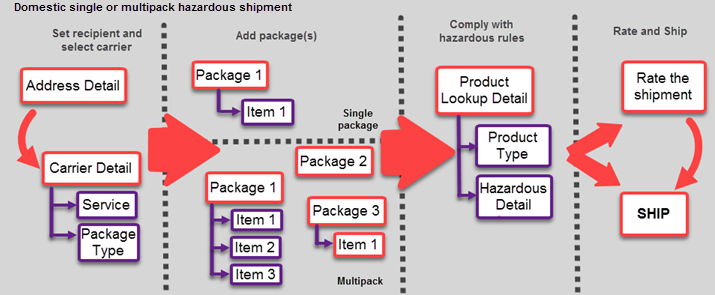
- Specify the address detail of the sender and the recipient. You can also provide additional detail, such as a return address, billing options, etc.
- Select the best carrier, service and package type based on your business objectives. Alternatively, enable automatic carrier selection.
- Set up standard package detail (weight, dimension, contents, etc.) and hazardous-specific, such as outer packaging type and quantity.
- Specify all required hazardous information. This will typically be the product id, name and its hazard class, packaging group and instructions, label codes, etc.
- If shipping more than one package, add another and repeat the setup steps. Note that if the next one is similar in weight and contents, you can clone the one you have already set up.
- Ship, or rate the shipment and then ship. You can review the total shipping cost, and change the carrier, if required.
The steps
Here's how to process a standard domestic hazardous single or multipack shipment in the MailCenter App. When successful, the App generates all relevant labels and documents, and makes them available to view and print.
- Open the App, and review the sender's address (Ship From). The address fields are automatically populated with the currently logged-in user's address detail. Change the details, if you wish to ship on account of somebody else.
- Select and validate the recipient's address (Ship To). Use the Address Book, or manually enter the details.
- Optionally, navigate between the remaining tabs, and set up additional details, such as billing address and options, return address, etc.
- Select a carrier, its service and package type, or select a rate group. If you select a rate group, on clicking RATE you access a popup (Rate Shop), and compare shipping price, delivery time and whether the service is guaranteed.
- Set up package detail: its contents, weight, dimensions, etc. The Weight field and the Hazardous Options section are mandatory.
- Specify the item/items included in the package. Add them into the Contents table at the bottom of the App, and fill in hazardous information using the Product Lookup (click LOOKUP).
- If shipping more than one package, provide the number of packages shipped. You must provide weight for each package that you add.
- Do one of the following:
- Click RATE to review the shipping cost, and then click SHIP to conclude the process.
- Click SHIP to conclude the process.
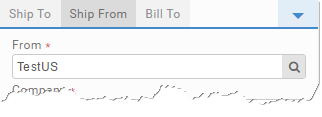
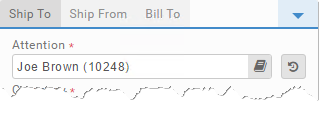
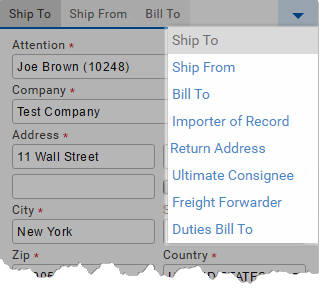

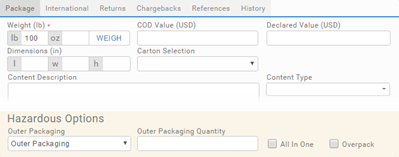


The standard domestic hazardous shipment is now processed, and you should be able to view and print its labels and documents.
Third party validated hazardous shipment
Here we outline this process and its steps. Use this as an overview and quick reference.
- 96 - LabelMaster DGIS. This is the default.
- 3 - UPS API.

- Specify the address detail of the sender and the recipient. You can also provide additional detail, such as a return address, billing options, etc.
- Select the best carrier, service and package type based on your business objectives. Alternatively, enable automatic carrier selection.
- Set up package detail (weight, dimension, contents, etc.). Note that you can mix hazardous and non-hazardous material in one package.
- Search for the product you wish to ship on the regulated hazardous materials list. Once you select the material, the third party sends back hazardous information, populating the required fields for you.
- Review hazardous information, and add more information, if required.
- If shipping more than one package, add another and repeat the setup steps. Note that if the next one is similar in weight and contents, you can clone the one you have already set up.
- Validate your shipment. You'll get a validation status message. Error messages mean that the validation has failed. You need to amend information, and validate the shipment again. As long as the validation fails, you can't ship. Warnings don't affect the process, and you can proceed with shipping the goods.
- Ship, or rate the shipment and then ship. You can review the total shipping cost, and change the carrier, if required.
The steps (third party validation)
Here's how to process a third party validated domestic single or multipack hazardous shipment in the MailCenter App. When successful, the App generates all relevant labels and documents, and makes them available to view and print.
- Open the App, and review the sender's address (Ship From). The address fields are automatically populated with the currently logged-in user's address detail. Change the details, if you wish to ship on account of somebody else.
- Select and validate the recipient's address (Ship To). Use the Address Book, or manually enter the details.
- Optionally, navigate between the remaining tabs, and set up additional details, such as billing address and options, return address, etc.
- Select the carrier, its service and the package type, or select a rate group. If you select a rate group, on clicking RATE you access a popup (Rate Shop), and compare shipping price, delivery time and whether the service is guaranteed.
- Set up package detail: its contents, weight, dimensions, etc. The Weight field and the Hazardous Options section are mandatory.
- Specify the item/items included in the package. Add them into the Contents table at the bottom of the App, and fill in hazardous information using the Hazardous Lookup (click MATERIALS).
- If shipping more than one package, provide the number of packages shipped. You must provide weight for each package that you add.
- Click VALIDATE. If the validation is successful, you can proceed with shipping. If the validation has failed, you must amend errors listed in the validation status message, and attempt to validate the shipment again. As soon as the validation status is successful, the SHIP button is enabled.
- Do one of the following:
- Click RATE to review the shipping cost, and then click SHIP to conclude the process.
- Click SHIP to conclude the process.







The third party validated domestic hazardous shipment is now processed, and you should be able to view and print its labels and documents.
See Use the MailCenter App for links to detailed content on the different tabs and components used in these two sets of steps.
- Use MailCenter - Hazardous outlines this hazardous setup in the App.
